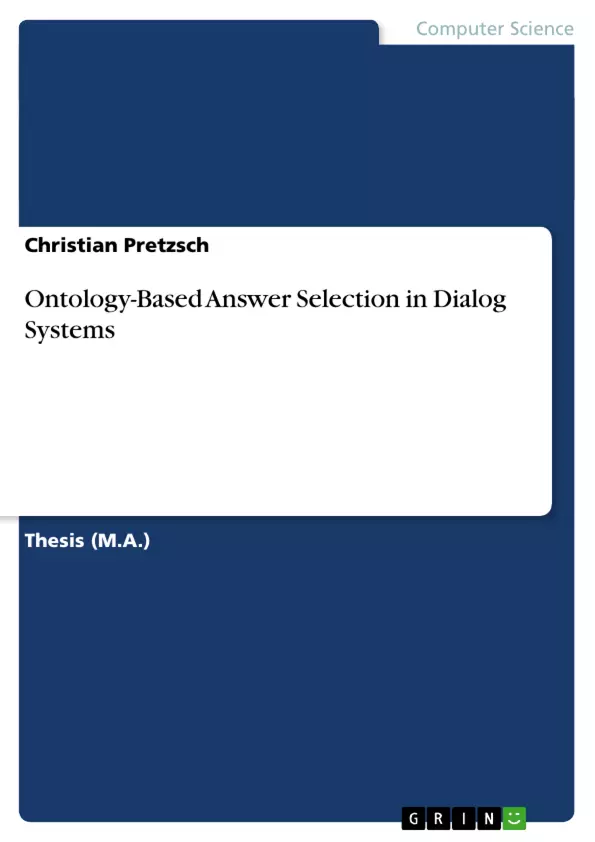In these days our daily life is more and more affected by computers, chips, electronic equipment, et cetera. Owing to this increase of technology, even in common everyday objects, like for example a fridge, it is necessary to find a simple and intuitive way to interact with complex technology. Natural language dialog systems could be the solution, or at least a part of it, how humans and machines could communicate or interact with each other. With the help of dialog systems people could access information and technical functionality of computers in a natural way using linguistic in- and output. One of the main tasks of such dialog systems is to provide fast and appropriate answers to user’s questions or requests. The challenge, therein, is how do we find these answers out of the flood of information.
Inhaltsverzeichnis (Table of Contents)
- Introduction
- Objective and Research Questions
- Project Goal
- Structure of this Work
- General Linguistics and Research Background
- Linguistics Background
- Human Computer Interaction
- Natural Language Processing
- Dialog and Discourse
- Dialog as Discourse
- Dialog as a Teleological Activity
- Dialog as a Collaborative/Cooperative Activity
- Speech Utterances in a Dialog
- Dialog Systems
- Evolution
- Field of Application
- Architecture and Components
- Dialog Management and Important Strategies
- Design Criteria
- Semantic Web, Smart Web, and Ontologies
- Semantic Web
- SmartWeb
- Semantic Similarity Measures
- Ontology
- General
- Ontologies as a Base of Modeling
- Ontologies for Communication
- Ontologies as Conceptual Models
- Important Aspects/Advantages
- RDF and RDFS
- Ontology-Languages
- Challenges
- State of the Art of Answer Selection
- Question Answering
- Answer Selection
- Selecting Answers with Ontologies
- Underlying Algorithms and Corpora
- OntoScore
- OntoScore Algorithm
- AnswerScore
- Agents and WrapperAgents
- Jena
- Jena API
- Used Ontology Technology
- EMMA
- DOLCE
- SUMO
- Sport Event
- SWInto
- Evaluating Semantic Relatedness for Answer Selection
- OntoScore Study
- OntoScore Analysis Part1
- Evaluation Score
- OntoScore Analysis Part 2
- Conclusion
- Semantic Density Approach
- ProperScore
- General Idea
- ProperScore Algorithm
- Implementation
- Results
- Ontology-based answer selection in dialog systems
- Semantic knowledge representation and reasoning
- Evaluation of ontology-based methods
- Integration of ontologies into dialog systems
- Improving answer selection accuracy and efficiency
- Introduction: This chapter outlines the objective and research questions of the thesis, specifically focusing on the goal of improving answer selection in dialog systems using ontologies. It also details the structure of the work.
- Linguistics Background: This chapter provides a comprehensive overview of key concepts in human-computer interaction, natural language processing, dialog and discourse, and dialog systems. It examines dialog systems from different perspectives, including their evolution, application fields, architecture, dialog management strategies, and design criteria.
- Semantic Web, Smart Web, and Ontologies: This chapter delves into the concepts of the Semantic Web and Smart Web, exploring the role of ontologies in facilitating semantic interoperability and knowledge sharing. It discusses different aspects of ontologies, including their general definition, applications in modeling, communication, and conceptual representation. The chapter also highlights important advantages, RDF and RDFS, ontology languages, and challenges associated with ontology development and use.
- State of the Art of Answer Selection: This chapter reviews existing research on answer selection in the field of question answering. It examines various approaches, including ontology-based techniques, for selecting relevant answers from a pool of candidates.
- Underlying Algorithms and Corpora: This chapter introduces the OntoScore algorithm, a method for scoring answers based on their semantic relatedness to the question. It also discusses other algorithms, tools, and resources used in this thesis, including AnswerScore, Agents and WrapperAgents, Jena API, and various ontology technologies like EMMA, DOLCE, SUMO, Sport Event, and SWInto.
- Evaluating Semantic Relatedness for Answer Selection: This chapter presents a study on the OntoScore algorithm, analyzing its performance in identifying semantically related answers. The study involves evaluating the algorithm's accuracy and effectiveness based on different metrics.
- Semantic Density Approach: This chapter introduces the ProperScore algorithm, an alternative approach for answer selection based on semantic density. It describes the general idea behind ProperScore, the algorithm itself, its implementation, and the resulting results.
Zielsetzung und Themenschwerpunkte (Objectives and Key Themes)
This thesis focuses on the development of ontology-based methods for answer selection in dialog systems. The goal is to improve the accuracy and efficiency of answer retrieval by leveraging semantic information from ontologies. This involves exploring and evaluating the use of ontologies for representing and reasoning about domain knowledge, and then integrating this knowledge into the answer selection process.
Zusammenfassung der Kapitel (Chapter Summaries)
Schlüsselwörter (Keywords)
This work focuses on the use of ontologies for answer selection in dialog systems. Key terms and concepts include dialog systems, natural language processing, semantic web, ontologies, semantic similarity, knowledge representation, answer selection, question answering, and evaluation metrics.
- Quote paper
- Bachelor of Arts / Magister Artium Christian Pretzsch (Author), 2006, Ontology-Based Answer Selection in Dialog Systems, Munich, GRIN Verlag, https://www.hausarbeiten.de/document/63949


